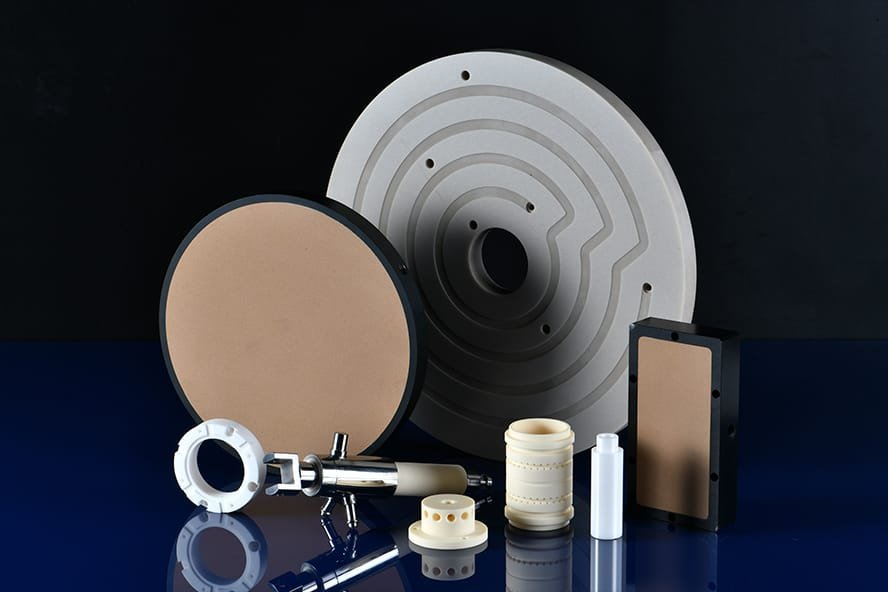什么是氧化铝陶瓷?
氧化铝陶瓷 通常是由氧化铝(Al₂O₃)粉末在高温下成型和烧结而成的高性能材料。由于具有高导热性、高耐磨性和耐腐蚀性等可靠性能,它们受到大多数工业应用的青睐。它们被广泛应用于半导体、航空航天、医疗和其他领域。

氧化铝陶瓷的特性
在许多工业应用中,对材料的要求很高。氧化铝陶瓷因其出色的物理和化学特性而脱颖而出。
- 硬度高:氧化铝陶瓷的莫氏硬度很高,因此耐磨损、耐刮擦。
- 电气绝缘:氧化铝陶瓷是一种出色的绝缘体,广泛应用于电气和电子领域。
- 耐化学性:它具有很强的耐腐蚀性,可确保在恶劣的化学环境中经久耐用。
- 重量轻,强度高:尽管氧化铝陶瓷重量轻,但其机械强度和刚度却令人印象深刻。
氧化铝陶瓷的应用
- 耐磨部件:用于机械中,以延长使用寿命和提高性能。
- 高温环境:炉衬、热交换器和窑炉的必备材料。
- 电气与电子
- 绝缘材料:高压电绝缘子的理想材料。
- 半导体:用于电子基板和电路。
- 医学和生物医学领域
- 假肢:用于关节置换和其他医疗植入物。
- 实验室器皿:确保生物医学测试和实验的精确性。
- 航空航天与国防
- 航空航天部件:因其轻质和热性能而备受推崇。
- 防弹:用于防弹装甲和其他防护设备。
氧化铝陶瓷是如何制成的
氧化铝陶瓷主要由铝土矿提炼成氧化铝粉而制成。以下是生产过程的简要概述
粉末制备
采购和加工高纯度氧化铝粉。
成型
粉末通过注塑、挤压或压制等技术成型。
烧结
定型部件在高温下加热,以达到所需的密度和强度。
加工
部件经过抛光或机加工,尺寸精确,表面光滑。
您为什么喜欢使用氧化铝陶瓷?
这是测试文本,单击 “编辑” 按钮更改此文本。
- 可持续性:氧化铝陶瓷可回收利用,有助于实现绿色环保。
- 成本效益高:与其他陶瓷材料相比,价格具有优势,其耐用性也确保了整体成本
- 可定制:可量身定制,以满足特定的工业或技术需求
氧化铝陶瓷实际案例
有关氧化铝陶瓷的常见问题
氧化铝陶瓷和氧化锆陶瓷的主要区别是什么?
氧化铝陶瓷的价值在于其硬度和导热性,而氧化锆陶瓷则具有卓越的韧性和抗冲击性。
哪些行业使用氧化铝陶瓷最多?
航空航天、电子、医疗设备和制造业等行业都非常依赖氧化铝陶瓷元件。
氧化铝陶瓷如何耐高温?
氧化铝陶瓷即使在超过 1500°C 的高温下也能保持结构完整性,因此非常适合极端环境。
为什么氧化铝具有良好的电气绝缘性能?
1.稳定的晶体结构
氧化铝是一种离子化合物,具有高度有序的刚玉结构(α-Al₂O₃)。在这种结构中,氧离子和铝离子紧密排列,形成牢固的离子键,极大地限制了自由电子的产生和移动,从而阻止了电荷的流动。
2.宽带隙
氧化铝的带隙约为 8.8 eV,属于宽带隙材料。这意味着它在室温下几乎没有自由载流子(电子或空穴),不能导电,因此具有良好的电绝缘性。
3.内在导电率低
氧化铝的本征电导率极低,因为晶体中几乎没有移动电荷载流子。此外,氧化铝中的杂质浓度通常很低,这进一步降低了杂质导致的电导率。
4.化学稳定性强
氧化铝具有良好的化学稳定性,即使在高温和恶劣环境下也能保持其结构和性能。这种稳定性确保它在恶劣条件下仍具有出色的绝缘能力。
5.介电强度高
氧化铝的介电强度(击穿电场强度)非常高,可达 12-15 kV/mm,因此能在强电场下保持电气绝缘性能,不易发生电气击穿。
总之,氧化铝优异的电绝缘性能源于其晶体结构、宽带隙、低本征电导率和稳定的物理化学性能,因此被广泛应用于电子、电气和高温绝缘领域。
